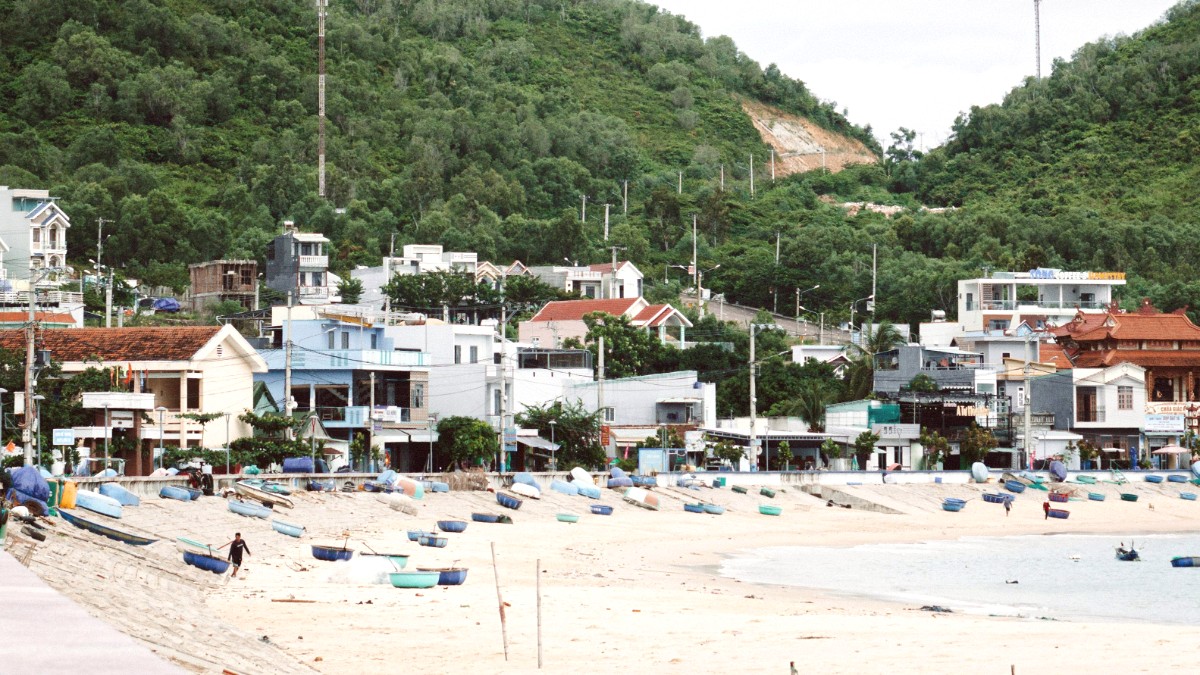
Vietnam
Ky Co Beach & Eo Gio (Nhon Ly Village): Approximately 20-25 kilometers north of Quy Nhon city. Reached by taxi, Grab, or motorbike to Nhon Ly village, then a 15-20 minute boat trip to Ky Co. Eo Gio is near Nhon Ly. Tours often bundle boat transport, snorkeling, and seafood lunch, simplifying logistics. Independent travel offers more flexibility but requires more negotiation. Half-day to full-day. Consider booking experiences through GetYourGuide.
Bánh Ít Cham Towers (Tháp Bánh Ít): Approximately 20 kilometers north of Quy Nhon. Accessible by taxi, Grab, or rented motorbike (30-40 minutes). Allow 1-2 hours to explore the towers and views. Quang Trung Museum (Tây Sơn District): Approximately 45 kilometers west of Quy Nhon. Best by taxi or private car (about 1 hour). A half-day trip covers the museum and grounds; check for martial arts performance times.
Quy Nhon's region presents stunning natural beauty beyond its main city beach.
A small, rocky island near Nhon Ly village. Features clear waters, good snorkeling, and a seasonal underwater walking path. Excellent for swimming and marine life observation. Access by boat tour from Nhon Ly fishing village, often combined with Ky Co Beach tours.
A larger, remote island offshore, featuring untouched beaches, a charming lighthouse, and a tranquil local village. Ideal for those seeking seclusion and natural beauty. Access requires a longer boat trip from Quy Nhon Port; consider a full-day excursion or an overnight stay.
Beyond the city's limits, the region presents insights into traditional Vietnamese village life and historical rural settings.
Nhon Ly, gateway to Ky Co and Eo Gio, displays an active fishing community. Observe local boats, fishermen mending nets, and daily rhythms. Enjoy fresh seafood, walk narrow alleys, and interact with locals.
A quiet, traditional village near the sand dunes. Offers a glimpse into rural Vietnamese life with rice fields, simple homes, and friendly locals. Walk or cycle through the village, observe farming, and enjoy the peaceful countryside.
Pagodas and temples around Quy Nhon function as important spiritual centers for the local community, offering opportunities for quiet reflection and cultural observation.
A visit to Nhon Ly, the access point to Ky Co and Eo Gio, presents an active fishing community. Observe local boats, fishermen mending nets, and the daily rhythms of coastal village life. Fresh seafood is available directly from the village.
This quiet, traditional village sits on the Phuong Mai Peninsula, near the sand dunes. It displays rural Vietnamese life, with rice fields, simple homes, and welcoming locals. Explore by walking or cycling.
Quy Nhon's location in Central Vietnam presents a logical stepping stone for longer regional explorations.
Highly popular and developed tourist destinations north of Quy Nhon. Da Nang offers modern city amenities and beaches. Hoi An is an UNESCO World Heritage site, famous for its ancient town, lanterns, and culinary scene. Many travelers combine Quy Nhon with Da Nang/Hoi An, creating a comprehensive Central Vietnam itinerary.
A larger, developed beach resort city south of Quy Nhon. Known for its long sandy beach, numerous islands, and bustling nightlife. Structured tourist activities include island hopping, mud baths, and Vinpearl Land. A common route starts in Ho Chi Minh City, travels north to Nha Trang, then Quy Nhon, and potentially further north.
For a contrasting experience, travel inland to the Central Highlands. Pleiku and Kon Tum present cooler climates, coffee plantations, waterfalls, and chances to learn about Vietnam's diverse ethnic minority groups and their traditional cultures. Combine a coastal trip with a few days in the highlands for varied landscapes and cultural experiences.
For extended travel, open-jaw flights (flying into one city and out of another) reduce travel time. Overnight trains or buses for longer distances may save on accommodation costs. Research accommodation and transport for your next destination beforehand.
Enhance your Central Vietnam adventure with these regional highlights.
Explore lantern-lit streets, tailor shops, and ancient architecture. UNESCO World Heritage status.
A lively resort city with long sandy beaches and numerous islands. Ideal for water sports and entertainment.
Discover coffee plantations, waterfalls, and ethnic minority cultures around Pleiku and Kon Tum.